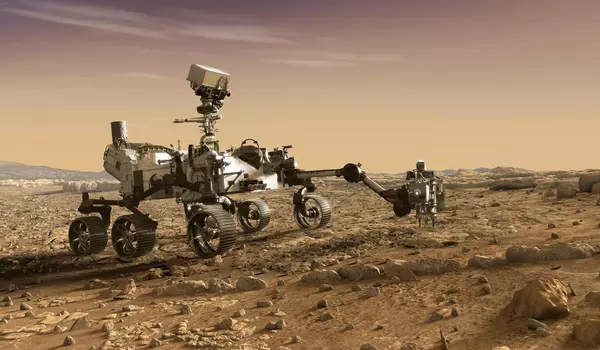The Perseverance rover, which landed on Mars on February 18, 2021, is equipped with a suite of scientific instruments that allow it to study the planet’s atmosphere in great detail. This includes an instrument called the Mars Environmental Dynamics Analyzer (MEDA), which measures temperature, wind speed and direction, pressure, relative humidity, and the amount and size of dust particles in the atmosphere.
Perseverance has now completed its atmospheric investigation for the first Martian year (which lasts approximately two Earth years). Astronomers have specifically studied seasonal and daily cycles of temperature and pressure, as well as significant variations on other time scales caused by very different processes.
Perseverance is a NASA autonomous vehicle that arrived at Mars’ Jezero Crater (the bed of an ancient, now-drying-up lake) on February 18, 2021. The rover is outfitted with seven novel, complex scientific instruments dedicated to exploring the planet’s surface in search of signs of possible past life, collecting and depositing samples to be returned to Earth, testing new technologies for use in human exploration, and thoroughly studying the planet’s atmosphere.
The MEDA (Mars Environmental Dynamics Analyzer) instrument has produced novel results in terms of studying the atmosphere. MEDA is led by José Antonio Rodrguez-Manfredi of the Centre for Astrobiology (CAB) in Madrid, and it includes a team from the UPV/Planetary EHU’s Sciences Research Group. The instrument is made up of a number of sensors that measure temperature, pressure, wind, humidity, and the properties of the dust that is always suspended in the Mars atmosphere.
The pressure and temperature of the Mars atmosphere oscillate with periods of the Martian solar day (somewhat longer than the Earth’s, it averages at 24 hrs 39.5 min) and with their submultiples, following the daily cycle of sunshine greatly influenced by the amount of dust and the presence of clouds in the atmosphere.
Agustín Sánchez-Lavega
Perseverance has now completed its atmospheric investigation for the first Martian year (which lasts approximately two Earth years). A sneak peek at the findings, which appears on the cover, is published today in the January issue of Nature Geoscience. The UPV/EHU team, led by Agustn Sánchez-Lavega, Ricardo Hueso, Teresa del Ro-Gaztelurrutia, and Ph.D. student Asier Munguira, has led the study of temperature and pressure seasonal and daily cycles, as well as significant variations on other time scales caused by very different processes.
The average air temperature at the Jezero Crater, located near the planet’s equator, is around minus 55 degrees Celsius throughout the seasons, but it varies greatly between day and night, with typical differences of around 50 to 60 degrees. The heating of the surface causes turbulent movements in the air during the day due to the rise and fall of air masses (convection), which cease in the evening when the air settles.
Pressure sensors, on the other hand, reveal the seasonal changes in the tenuous Martian atmosphere caused by melting and freezing of atmospheric carbon dioxide at the polar caps, as well as a complex, variable daily cycle modulated by thermal tides in the atmosphere.

“The pressure and temperature of the Mars atmosphere oscillate with periods of the Martian solar day (somewhat longer than the Earth’s, it averages at 24 hrs 39.5 min) and with their submultiples, following the daily cycle of sunshine greatly influenced by the amount of dust and the presence of clouds in the atmosphere,” says Agustín Sánchez-Lavega, professor at the Faculty of Engineering — Bilbao (EIB) and co-researcher on the Mars 2020 mission.
Both sensors are also detecting dynamic phenomena in the atmosphere that occur near the rover, such as those caused by the passage of whirlwinds known as “dust devils” due to the dust they occasionally kick up, or the generation of gravity waves whose origin is unknown. “Dust devils are more common at Jezero than elsewhere on Mars, and they can grow to be quite large, forming whirlwinds up to 100 meters in diameter. With MEDA, we were able to characterize not only their general characteristics (size and abundance), but also how these whirlwinds function” Ricardo Hueso, lecturer at the Faculty of Engineering in Bilbao, agrees (EIB).
MEDA has also detected the presence of storms thousands of kilometers away, with origins similar to terrestrial storms, as shown by images from orbiting satellites, and which move along the edge of the north polar cap, formed by carbonic snow deposition.
MEDA was able to characterize in detail the changes in the atmosphere caused by one of the dreaded dust storms, such as the one that developed in early January 2022, among the rich variety of phenomena studied. Its passage over the rover caused abrupt temperature and pressure changes, as well as strong gusts of wind that kicked up dust and struck the instruments, damaging one of the wind sensors.
“MEDA provides high-precision meteorological measurements that allow the Martian atmosphere to be characterised for the first time at local scales of a few meters as well as on the global scale of the planet by collecting data on what is happening thousands of kilometers away. All of this will help us understand the Martian climate and improve the predictive models we use “Sánchez-Lavega explains.





